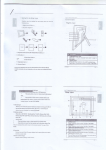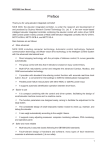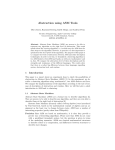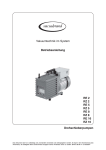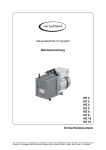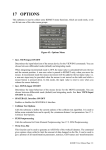Download AsmetaL: a user guide
Transcript
AsmetaL - A user guide
February 23, 2011
This user’s guide wants to be an introduction to the AsmetaL language and to
show the problems a user could find when he starts writing code in this language.
A prerequisite for the lecture of the text is the knowledge of ASM theory [1]. For
a complete description of AsmetaL syntax you can refer to the ASMETA web site
[2] and in particularly to the guide of notation [3]. In the text, sometimes, we
will use some short examples to underline some concepts; we will also use the
complete models of the ATM and LIFT specifications: because of their lengths
they are reported at the end of the text (sections 8.1 and 8.2).
Contents
1
ASM structure
2
2
Domain and function declaration
3
3
Body and main rule
3.1 Static domains, variables and functions initialization
3.2 Derived functions . . . . . . . . . . . . . . . . . . .
3.3 Rules . . . . . . . . . . . . . . . . . . . . . . . . .
3.4 Main rule . . . . . . . . . . . . . . . . . . . . . . .
.
.
.
.
.
.
.
.
.
.
.
.
.
.
.
.
.
.
.
.
.
.
.
.
.
.
.
.
5
5
6
6
7
4
Initialization
7
5
Monitored function
5.1 At what state the monitored functions values belong? . . . . . . .
5.2 How to use monitored functions . . . . . . . . . . . . . . . . . .
5.3 How to identify monitored functions . . . . . . . . . . . . . . . .
8
8
9
10
6
Invariants
6.1 Invariants declaration . . . . . . . . . . . . . . . . . . . . . . . .
6.2 Invariants violation . . . . . . . . . . . . . . . . . . . . . . . . .
10
11
11
7
Inconsistent updates
12
1
8
1
Examples
8.1 ATM specification . . . . . . . . . . . . . . . . . . . . . . . . . .
8.2 LIFT specification . . . . . . . . . . . . . . . . . . . . . . . . . .
15
15
19
ASM structure
An ASM model is structured into four sections: an header, a body, a main rule and
an initialization. In code 1 is shown an ASM model for the factorial calculation;
let’s examine it to understand the structure of an ASM model.
asm factorial
import ../STDL/StandardLibrary
signature:
dynamic
dynamic
dynamic
dynamic
derived
monitored value: Integer
controlled index: Integer
controlled factorial: Integer
controlled outMess: Any
continue: Integer -> Boolean
definitions:
function continue($i in Integer) =
$i>1
macro rule r_factorial =
if(continue(index)) then
seq
factorial := factorial*index
index := index-1
endseq
endif
main rule r_Main =
seq
if(index=1) then
if(value>0) then
par
index := value
factorial := 1
outMess := "Executing the factorial"
endpar
else
outMess := "Insert a value greater than zero"
endif
endif
r_factorial[]
endseq
default init s0:
function index = 1
Code 1: Example of an ASM model: Factorial
At the beginnig of the file we must insert the keyword asm followed by the
name of the model, that must be equal to the file name (case sensitive).
2
If the ASM is an asynchronous multi-agent, the keyword asyncr must be inserted
before the keyword asm; by default an ASM is considered a synchronous multiagent.
In the header section, we can import external modules in the following way:
import extModule
where import is a keyword and extModule is the relative path of the module we
want to import. In our example we have imported the module StandardLibrary
that contains many useful functions and that is nedeed by almost all non-trivial
ASM models. A copy of the StandardLibrary can be downloaded from [5].
Then, after the keyword signature, we can define the signature of domains and
functions (see section 2).
In the body section (see section 3), we must insert (in this order) the implementation of static concrete domain, of derived and static functions and of the rules of
our model.
After the body section we can insert the main rule (see section 3); if we are
writing an ASM module1 , the main rule must be omitted.
At the end, in the initialization section (see section 4), we can insert the initialization of controlled functions.
2
Domain and function declaration
In code 1 we can see that each function signature reports, after the colon, the
codomain of the function.
Let’s see how to use and declare domains in an ASM model.
There are several types of domains. First of all, we can choose from some basic
type domains: Complex, Real, Integer, Natural, String, Char, Boolean, Rule, and
Undef2 . For example, in the ATM example (section 8.1) the function moneyLeft
has been declared as an Integer.
Moreover we can define an abstract type domain that can be useful to represents entities of real word; in example 8.1 we have defined an abstract domain
NumCard. The static functions card1, card2 and card3 has been declared as NumCard. Through the use of an abstract domain we do not have to worry about the
representation of the credit card. Maybe, in a refinement step, we could change the
domain and decide to identify the credit cards with integers or strings.
Sometimes could be useful to have a function that can assume values of different types: in this case we can define the function over an anydomain. In the ATM
example the function outMess is used to show messages to the user; these messages can contain both strings and numbers: for this reason the function has been
associated to the Any domain (is an anydomain defined in the Standard Library).
1
An ASM module is an ASM without a main rule and without a characterization of the set of
initial states. In an ASM module, before the name of the model we must insert the keyword module
(and not asm).
2
We can see that the first letter of the name of a domain must be upper-case.
3
In the same example we can see another type of domain: the enum domain. The
enum domain is useful to define an enumeration of elements; in the ATM example
the domain Service contains the three services supplied by the ATM (“BALANCE
“, “WITHDRAWAL”, “EXIT”). The function selectedService takes values in Service.
Finally it’s possible to define concrete domains that are subsets of type domains. In the ATM example the domain MoneySize is a concrete domain, subset of
Integer.
Moreover it is possible to define domains through the application of some set
operators to type domains. These are: ProductDomain, SequenceDomain, PowersetDomain, BagDomain and MapDomain.
In the previous text we have respected the theory of the ASM and we have
called functions even the entities that, in a programming language, are called variables. In fact moneyLeft, outMess and selectedService can be used as variables.
In a programming language point of view a function is an application that takes
values from a input domain and returns values in an output domain; an example of
that can be the pin function: it takes values from the Numcard domain and returns
Integer values.
Sometimes a function takes more than a value as input; in this case the input
domain must be defined as a Product domain of the type domains concerned. In
the LIFT example (section 8.2) the function
dynamic controlled hasToDeliverAt: Prod(Lift, Floor) -> Boolean
, for each pair ($l in Lift, $f in Floor), is true if someone at lift $l has selected the
floor $f as destination.
Sometimes it could be useful to define a list (or array) of elements; this can
be done through a sequence domain. Let’s see in code 2 the model that generate a
sequence of Fibonacci numbers.
asm fibonacci
import ../STDL/StandardLibrary
signature:
dynamic
dynamic
dynamic
dynamic
monitored size: Integer //number of Fibonacci numbers
controlled num_fibo: Integer
controlled index: Integer
controlled succ_fibo: Seq(Integer)
definitions:
macro rule r_insert_number =
if(num_fibo=2) then
num_fibo := size
endif
macro rule r_fibonacci =
if(index<num_fibo) then
seq
succ_fibo := append(succ_fibo,at(succ_fibo,iton(index-1))+
at(succ_fibo,iton(index-2)))
indice := indice+1
4
endseq
endif
main rule r_Main =
seq
r_insert_number[]
r_fibonacci[]
endseq
default init s0:
function succ_fibo = [1, 1]
function index = 2
function num_fibo = 2
Code 2: Fibonacci sequence
The domain of succ_fibo is Seq(Integer); all the essential function to manipulate a sequence are defined in the Standard Library [5]. In the example we use the
at operator to select the last two elements and the append operator to add the new
element to the sequence.
3
3.1
Body and main rule
Static domains, variables and functions initialization
In the body section the user must set the values of static concrete domains and static
functions. In the ATM example (section 8.1) we can see that, at the beginning of
the definitions section, we have defined the values of MoneySize domain (10, 20,
40, 50, 100, 150, 200). In the same example we have also set the values of the
static ’variables’ minMoney and maxWithdrawal that are constants that represent
the minimal amount of money that the ATM machine must always contain and the
maximum amount that a user can withdraw.
Then we can see the definition of a static function; a static function is used
when there is a fixed connection between the elements of domain and codomain.
In the ATM example the function pin associates each card to its pin number.
For completeness let’s see the definition of a static function that has two parameters (code 3). The example is taken from [4] where is described “the control
of a package router to sort packages into bins according to their destinations”. The
static function dir (code 3) implements a routing table for the switches, elements
that the computer can flip to route a package to its destination bin.
function dir($sw in SwitchBin, $b in Bin) =
switch($sw, $b)
case (switch0_1, bin1): LEFT
case (switch0_1, bin2): LEFT
case (switch0_1, bin3): RIGHT
case (switch0_1, bin4): RIGHT
case (switch1_1, bin1): LEFT
case (switch1_1, bin2): RIGHT
case (switch1_1, bin3): NONE
case (switch1_1, bin4): NONE
5
case (switch1_2,
case (switch1_2,
case (switch1_2,
case (switch1_2,
endswitch
bin1):
bin2):
bin3):
bin4):
NONE
NONE
LEFT
RIGHT
Code 3: Package router control: static dir function
In this case the switch operator has been applied to a couple of elements; in
general it can be applied to any n-tuple of elements.
3.2
Derived functions
In the body section, also the derived functions must be defined. A derived function
is a function whose return value is subjected to its inputs. In the ATM example the
function
derived allowed: Prod(NumCard, Integer) -> Boolean
return true if the balance of the card $c is greater than or equal to the requested
amount of money $m. We can observe two derived functions also in the LIFT
example: canContinue and attracted.
3.3
Rules
After the definition of domains and functions, the rules definition can be inserted.
Each function name must start with the string r_. The order in which the rules are
defined is very important; for example, if a rule r_b[] calls a rule r_a[], r_a[] must
be defined before r_b[]. This means that, by now, it’s not possible to implement an
indirect recursion between rules (r_a[] calls r_b[] and r_b[] calls r_a[]).
There are two types of rule, macro and turbo. A macro rule must be called with
squared brackets; a turbo one, instead, needs round brackets.
In all the examples encountered previously, we have always seen only macro
rules. Let’s now see in code 4 the use of a turbo rule.
asm recursive_factorial
import ../STDL/StandardLibrary
signature:
dynamic controlled value: Integer
definitions:
turbo rule r_factorial($n in Integer) in Integer =
local x : Integer [ x:=1 ]
if($n=1) then
result := 1
else
seq
x <- r_factorial($n-1)
result := $n*x
endseq
endif
6
main rule r_Main =
r_factorial(value)
default init s0:
function value = 5
Code 4: Example of turbo rule: Recursive factorial
In the example the rule r_factorial is a TurboReturnRule; the type of return
value is defined in the rule signature (in this case “in Integer”). The return value of
the rule is the standard variable result.
We can notice that in this example a local variable x has been used.
3.4
Main rule
After the body section, the main rule can be inserted. In general the structure of
the main rule depends on the ASM specification we are writing and, also, on our
“programming style”. Nonetheless, in our experience, we have seen that often it is
possible to structure our code in order to reproduce the different states of the ASM
and the constraints that guard the passage from a state to another.
We have used two different approaches; in the first one, the structure of the
finite state machine is visible. In the LIFT example (section 8.2) a r_FSM rule
simulates the passage from a state to another: it takes as parameters the starting
state ($s1), the guard of the transition ($cond), the rule to execute if the condition
is true ($rule) and the final state ($s2). In the main rule all the possible transitions
are evaluated in parallel.
In the second approach, instead, the structure of the FSM disappear; the guards
and the state transitions are included in the rules. An example of this approach is
the ATM example (section 8.1). Let’s see for example the r_insertcard[] rule. The
first instruction checks if the ATM is in the AWAITCARD state; in this case, if the
$c card inserted is a valid card, the ATM can pass in the AWAITPIN state. Using
this approach, in the main rule, the rules themselves (r_insertcard[], r_enterPin[],
r_chooseService[], r_chooseAmount[], r_withdrawal[]) are evaluated in parallel.
4
Initialization
In the initialization section we can initialize the controlled functions. The techniques are the same that we have seen for static functions in section 3.1. If the
initial value of a function is not specified, all its locations take the undef value.
Although the parser does not force you to initialize all the controlled functions,
we strongly suggest to do it because, often, a missing initialization can cause a
run-time error3 .
3
The simulator, in some situations, is not able to deal with the undef value.
7
5
Monitored function
An ASM machine can communicate with the environment (the user) through the
monitored functions. The values of the monitored functions can be passed to the
AsmetaS simulator [2] in an interactive way (command-line) or by setting an environment file (file.env). What mode is recommended? Usually it’s useful to execute
a first run of our model in the interactive way, to discover in what order the monitored functions are requested; in fact it could be difficult to predict the correct
order when the code is particularly complex. In code 1 the first three transaction
of the ATM specification are shown. The simulator asks the user for the value of
insertedCard, insertedPin and selectedService.
In code 5 the environment file that reproduces the same execution shown in
figure 1 is shown. The # symbol is used to introduce comment lines; the file could
contain only three lines with the values ’card1’, ’1’ and ’BALANCE’. The commented lines are not essential; they have been inserted to make the file more readable to the user.
5.1
At what state the monitored functions values belong?
In this section we want to describe exactly how an ASM state is built and, in particular, how and when the monitored functions contribute to the building of the ASM
state.
Let’s see figure 1 in which the output of an AsmetaL model simulation is shown;
you can see that the information about the function values in state i is divided in
two part:
• <State i (controlled)>. . . </State i (controlled)> contains the values of the
controlled functions;
• <State i (monitored)>. . . </State i (monitored)> contains the values of the
monitored functions.
The information is divided in such a way because the values of the controlled functions and of the monitored functions are obtained in two different moments and it
is more convenient to show them separately.
Let’s see, through the observation of the simulation output, how the ASM state
evolves during the simulation:
1. in the initial state the values of the controlled functions are set; you can
imagine that the initial state contributes to build <State 0 (controlled)>;
2. in order to complete the state 0, the values of the monitored functions are
needed: these are requested to the user and are reported in the console in
the <State 0 (monitored)>4 ; in this example the simulator reports that the
monitored function insertedCard has value card1;
4
We will see in section 5.2 that, in a given state, just the values of monitored functions that can
be read are requested; for this reason, some monitored functions could not be shown in some states.
8
3. at this point, the state 0 is complete and the simulator can calculate the update
set; the update set is applied and the controlled part of state 1 (<State 0
(controlled)>) can be shown;
4. now the simulator asks again for monitored functions values and so on . . .
It is important to notice that at the ith step, after having read the monitored
functions values, the simulator prints the monitored functions values of state i − 1
and the controlled functions values of state i; indeed, the monitoring functions
values permit to complete the previous state and from that calculate the update set
that gives the controlled part of the new state.
5.2
How to use monitored functions
The theory of ASM says that, in any state, the values of all monitored functions
must be determined; nonetheless it’s important to notice that, in some states, a rule
cannot fire independently from the values of the monitored functions that belong to
its scope. For this reason, the simulator asks the user for the value of a monitored
function only when needed (lazy evaluation). So, in writing an AsmetaL model,
it’s useful to neste as much as possible the use of monitored functions in order to
minimize the number of requests of the simulator. In the following example:
signature:
enum domain State={A, B}
monitored function continue: boolean
definitions:
r_stateA[] =
skip
rule r_main =
if(State=A and continue=true) then
r_stateA[]
endif
Code 5: Example of monitored function
the simulator asks for the value of continue even if the value of State is not A.
The main rule can be re-written in the following way:
rule r_main =
if(State=A) then
if(continue=true) then
r_stateA[]
endif
endif
Code 6: Main rule rewritten
Obviously the two versions of the main rule are equivalent but, in the latter
format, the simulator asks for the value of continue only when the function State is
A.
In many situations this trick can be easily applied.
9
5.3
How to identify monitored functions
Let’s see, thanks to a case study, how to identify the monitored functions of a
system and the problems that could influence our choice.
First of all, it’s important to remember that, through the monitored functions,
the user says to the simulator that something happened in the environment, but
that he should not have to worry about the duration of the effect produced by the
monitored functions values. In other words, the user should not have to confirm
the value of a monitored function whose value remains unchanged for more than a
transition.
A good example of that is provided by the well known Lift study case [1]; in
this example the functions existsCallFromTo(Floor, dir) and hasToDeliverAt(Lift,
Floor) are boolean functions that, respectively, indicate if there is a call from a
floor (to go up or down) and if there is call from a user inside the lift to go to a
floor. These functions are defined as shared because they can be set to true by the
user, when he calls the lift, and set to false by the lift when he reaches the selected
floor. Since, at the moment, the simulator does not support shared functions, we
have to define these two functions as monitored: this introduce a problem. For the
sake of simplicity we analyse the case with one lift.
These functions values must be set in a given state and have to be kept until the
lift has reached the selected floor. The problem is that, in any state, the simulator asks for the value of monitored functions: since we could not know (and we
don’t want to) if the lift has reached the floor, we argue that, probably is not a
good idea to define existsCallFromTo and hasToDeliverAt as monitored functions.
So, we have declared existsCallFromTo and hasToDeliverAt as controlled function
and introduced two new monitored functions insideCall(Lift, Floor) and outsideCall(Floor, Dir); insideCall($l, $f) must be set to true if, in a state, a user inside
the lift $l has selected the floor $f. In the same way, outsideCall($f, $d) must be
set to true if, in a state, a user at floor $f has pressed the button to go in $d direction. existsCallFromTo and hasToDeliverAt are modified according to the values of
the two monitored functions. It is important to notice that the monitored functions
must be set to true only when the call happens. If there is no call, the monitored
functions must be set to false. It’s clear that the number of monitored functions
does not change in the two versions, but in the latter one their use is much more
easy: in fact the user must set a monitored function only when he wants to make a
call, but he does not have to worry about the duration of the effects of his call (the
number of transitions requested by the lift to reach the floor selected).
6
Invariants
In the ASM theory, invariants are used to express constraints over functions and
rules. In writing an AsmetaL model the use of invariants can be useful to discover
modeling errors. In general, the absence of invariants violations can not be considered as a proof of the correctness of a specification, but a violation of an invariant,
10
instead, is a proof of its wrongness.
6.1
Invariants declaration
Invariants must be declared just before the main rule; each invariant must be declared through the use of the keyword invariant and associated to a name invariant_name5 . An invariant expresses a constraint over some functions and rules of
the specification: these must be listed after the keyword over. In code 7 term indicates the boolean term which expresses the constraint.
invariant invariant_name over id_function,...,id_rule : term
Code 7: Structure of an invariant
6.2
Invariants violation
In code 8 we can see an example of use of invariants.
asm invariant_example
import ../../../STDL/StandardLibrary
signature:
dynamic controlled fooA: Integer
dynamic controlled fooB: Integer
dynamic monitored monA: Boolean
dynamic monitored monB: Boolean
definitions:
macro rule r_a =
if(monA) then
fooA := fooA + 1
endif
macro rule r_b =
if(monB) then
fooB := fooB + 1
endif
invariant over fooA, fooB: fooA != fooB
main rule r_main =
par
r_a[]
r_b[]
endpar
default init s0:
function fooA = 1
function fooB = 0
Code 8: Specification with invariant
5
An invariant name must start with the string inv_
11
The invariant says that the functions fooA and fooB cannot be equal. In code 9
we can see the execution of the specification shown in code 8 and the violation of
the invariant.
Insert a boolean constant
true
Insert a boolean constant
true
<State 0 (monitored)>
monA=true
monB=true
</State 0 (monitored)>
<State 1 (controlled)>
fooA=2
fooB=1
</State 1 (controlled)>
Insert a boolean constant
false
Insert a boolean constant
true
<State 1 (monitored)>
monA=false
monB=true
</State 1 (monitored)>
<State 2 (controlled)>
fooA=2
fooB=2
</State 2 (controlled)>
<Invariant violation>
neq(fooA,fooB)
</Invariant violation>
Final state:
fooA=2
fooB=2
for monA:
for monB:
for monA:
for monB:
Code 9: Invariant violation
In the initial state the invariant is satisfied: indeed fooA and fooB are different (1
and 0).
Also in the first transition the invariant has been satisfied: fooA is 2 and fooB is 1.
In the second transition, instead, the two functions assume the same value (2);
the invariant has not been satisfied and the execution has been stopped. In this
case the violation of the invariant has been caused by a wrong setting of monitored
functions by the user.
7
Inconsistent updates
When we write an ASM specification (and so the corresponding AsmetaL code) we
usually try to avoid the occurrence of an inconsistent update during the execution
of the code. The parser can discover only trivial inconsistent updates (for example
a function whose value is modified by two parallel instruction in the same rule);
the other inconsistent updates will occur at run-time. If the inconsistent update is
caused by a bad code, this can be simply resolved by a good programmer.
Sometimes, instead, inconsistent updates can be caused by the values that the user
12
assigns to monitored functions; we would like that the user could always set any
values he wants to monitored functions but, sometimes, this is not possible. In code
10 is shown a possible code for the dining philosophers problem [6].
asm philosophers
import ../STDL/StandardLibrary
signature:
domain Philosophers subsetof Agent
abstract domain Fork
monitored hungry : Philosophers -> Boolean
controlled eating : Philosophers -> Boolean
static right_fork : Philosophers -> Fork
static left_fork : Philosophers -> Fork
controlled owner : Fork -> Philosophers
static phil_1: Philosophers
static phil_2: Philosophers
static phil_3: Philosophers
static phil_4: Philosophers
static phil_5: Philosophers
static fork_1: Fork
static fork_2: Fork
static fork_3: Fork
static fork_4: Fork
static fork_5: Fork
definitions:
function right_fork($a in Philosophers) =
if $a = phil_1 then fork_2
else if $a = phil_2 then fork_3
else if $a = phil_3 then fork_4
else if $a = phil_4 then fork_5
else if $a = phil_5 then fork_1
endif endif endif endif endif
function left_fork($a in Philosophers) =
if $a = phil_1 then fork_1
else if $a = phil_2 then fork_2
else if $a = phil_3 then fork_3
else if $a = phil_4 then fork_4
else if $a = phil_5 then fork_5
endif endif endif endif endif
macro rule r_Eat =
if (hungry(self)) then
if ( isUndef(owner(left_fork(self))) and
isUndef(owner(right_fork(self))) ) then
par
owner(left_fork(self)) := self
owner(right_fork(self)) := self
eating(self) := true
endpar
endif
endif
macro rule r_Think =
if ( not hungry(self)) then
if (eating(self) and owner(left_fork(self)) = self and
owner(right_fork(self)) = self )then
13
par
owner(left_fork(self)) := undef
owner(right_fork(self)) := undef
eating(self) := false
endpar
endif
endif
main rule r_choose_philo =
forall $p in Philosophers with true do program($p)
default init initial_state:
function eating ($p in Philosophers)= false
function owner ($f in Fork) = undef
agent Philosophers :
par
r_Eat[]
r_Think[]
endpar
Code 10: Five philosophers
The users must set the values of the monitored function hungry($p in Philosophers) (i.e. the values of the function locations) to identify the philosophers that
want to eat. This model makes the assumption that the user will respect the concurrency on the use of the forks and, so, that will never let two neighbour philosophers
eat at the same time. In fact, the following execution causes an inconsistent update
since phil_4 and phil_5 cannot eat at the same time:
INFO - <Run>
INFO - <Transition>
Insert a boolean constant for hungry(phil_4):
true
Insert a boolean constant for hungry(phil_5):
true
Exception in thread "main" org.asmeta.interpreter.UpdateClashException
Code 11: Five philosophers
14
8
8.1
Examples
ATM specification
asm ATM
import ../../STDL/StandardLibrary
signature:
abstract domain NumCard
enum domain State = { AWAITCARD | AWAITPIN | CHOOSE | OUTOFSERVICE |
CHOOSEAMOUNT | STANDARDAMOUNTSELECTION | OTHERAMOUNTSELECTION}
domain MoneySize subsetof Integer //tagli selezionabili
enum domain Service = {BALANCE | WITHDRAWAL | EXIT}
enum domain MoneySizeSelection = {STANDARD | OTHER}
dynamic controlled currCard: NumCard
dynamic controlled atmState: State
dynamic controlled outMess: Any
static pin: NumCard -> Integer
dynamic controlled accessible: NumCard -> Boolean
dynamic controlled moneyLeft: Integer
dynamic controlled balance: NumCard -> Integer
dynamic controlled numOfBalanceChecks: Integer
dynamic
dynamic
dynamic
dynamic
dynamic
dynamic
monitored
monitored
monitored
monitored
monitored
monitored
insertedCard: NumCard
insertedPin: Integer
selectedService: Service
insertMoneySizeStandard: MoneySize
insertMoneySizeOther: Integer
standardOrOther: MoneySizeSelection
derived allowed: Prod(NumCard, Integer) -> Boolean
static card1: NumCard
static card2: NumCard
static card3: NumCard
static minMoney: Integer
static maxPrelievo: Integer
definitions:
domain MoneySize = {10, 20, 40, 50, 100, 150, 200}
function minMoney = 200
function maxPrelievo = 1000
function pin($c in
switch($c)
case card1
case card2
case card3
endswitch
NumCard) =
: 1
: 2
: 3
function allowed($c in NumCard, $m in Integer) =
balance($c) >= $m
macro rule r_subtractFrom ($c in NumCard, $m in Integer) =
balance($c) := balance($c) - $m
15
macro rule r_goOutOfService =
par
atmState := OUTOFSERVICE
outMess := "Out of Service"
endpar
macro rule r_insertcard =
if(atmState=AWAITCARD) then
if(exist $c in NumCard with $c=insertedCard) then
par
currCard := insertedCard
atmState := AWAITPIN
outMess := "Enter pin"
endpar
endif
endif
macro rule r_enterPin =
if(atmState=AWAITPIN) then
if(insertedPin=pin(currCard) and accessible(currCard)) then
par
outMess := "Choose service"
atmState := CHOOSE
numOfBalanceChecks := 0
endpar
else
par
atmState := AWAITCARD
if(insertedPin!=pin(currCard)) then
outMess := "Wrong pin"
endif
if(not(accessible((currCard))) and insertedPin=pin(
currCard)) then
outMess := "Account non accessible"
endif
endpar
endif
endif
macro rule r_chooseService =
if(atmState=CHOOSE) then
par
if(selectedService=BALANCE) then
if(numOfBalanceChecks = 0) then
par
numOfBalanceChecks := numOfBalanceChecks + 1
outMess := balance(currCard)
endpar
else
par
atmState := AWAITCARD
outMess := "You can check only once your
balance. Goodbye."
endpar
endif
endif
if(selectedService=WITHDRAWAL) then
par
atmState := CHOOSEAMOUNT
outMess := "Choose Standard or Other"
endpar
endif
16
if(selectedService=EXIT) then
par
atmState := AWAITCARD
outMess := "Goodbye"
endpar
endif
endpar
endif
rule r_chooseAmount =
if(atmState=CHOOSEAMOUNT) then
par
if(standardOrOther=STANDARD) then
par
atmState := STANDARDAMOUNTSELECTION
outMess := "Select a money size"
endpar
endif
if(standardOrOther=OTHER) then
par
atmState := OTHERAMOUNTSELECTION
outMess := "Enter money size"
endpar
endif
endpar
endif
rule r_grantMoney($m in Integer)
par
r_subtractFrom[currCard,
moneyLeft := moneyLeft seq
accessible(currCard)
accessible(currCard)
endseq
atmState := AWAITCARD
outMess := "Goodbye"
endpar
=
$m]
$m
:= false
:= true
macro rule r_processMoneyRequest ($m in Integer) =
if(allowed(currCard, $m)) then
r_grantMoney[$m]
else
outMess := "Not enough money in your account"
endif
macro rule r_prelievo =
par
if(atmState=STANDARDAMOUNTSELECTION) then
if(exist $m in MoneySize with $m=insertMoneySizeStandard)
then
if(insertMoneySizeStandard<=moneyLeft) then
r_processMoneyRequest [insertMoneySizeStandard]
else
outMess := "Il bancomat non ha abbastanza soldi"
endif
endif
endif
if(atmState=OTHERAMOUNTSELECTION) then
if(mod(insertMoneySizeOther, 10)=0) then
if(insertMoneySizeOther<=moneyLeft) then
r_processMoneyRequest [insertMoneySizeOther]
17
else
outMess := "Il bancomat non ha abbastanza soldi"
endif
else
outMess := "Tagli non compatibili"
endif
endif
endpar
main rule r_Main =
if (moneyLeft < minMoney) then
r_goOutOfService[]
else
par
r_insertcard[]
r_enterPin[]
r_chooseService[]
r_chooseAmount[]
r_prelievo[]
endpar
endif
s0:
atmState = AWAITCARD
moneyLeft = 1000
balance($c in NumCard) = switch($c)
case card1 : 3000
case card2 : 1652
case card3 : 548
endswitch
function accessible($c in NumCard) = true
default init
function
function
function
18
8.2
LIFT specification
asm LIFT
import ../STDL/StandardLibrary
signature:
abstract domain Lift
enum domain Dir = {UP | DOWN}
domain Floor subsetof Integer
enum domain State = {HALTING | MOVING}
dynamic controlled direction: Lift -> Dir
dynamic controlled ctlState: Lift -> State
dynamic controlled floor: Lift -> Floor
derived attracted: Prod(Dir, Lift) -> Boolean
derived canContinue: Prod(Dir,Lift) -> Boolean
dynamic
dynamic
dynamic
dynamic
static
static
static
static
controlled hasToDeliverAt: Prod(Lift, Floor) -> Boolean
controlled existsCallFromTo: Prod(Floor, Dir) -> Boolean
monitored insideCall: Prod(Lift, Floor) -> Boolean
monitored outsideCall: Prod(Floor, Dir) -> Boolean
plusorminus: Dir -> Integer
opposite: Dir -> Dir
ground: Integer
top: Integer
static lift1: Lift // there is one lift
definitions:
domain Floor = {0..+2}
function ground = 0
function top = 2
function plusorminus($d in Dir) =
if($d = UP) then
1
else
-1
endif
function opposite ($d in Dir) =
if ($d = UP) then
DOWN
else
UP
endif
function canContinue($d in Dir, $l in Lift) =
((($d =UP) and (attracted(UP,$l) and not(hasToDeliverAt($l,floor($l))
)
and not(existsCallFromTo(floor($l),UP))))
or (($d =DOWN) and (attracted(DOWN,$l) and not(hasToDeliverAt($l,
floor($l)))
and not(existsCallFromTo(floor($l),DOWN)))) )
function attracted($d in Dir, $l in Lift) =
if($d = UP) then
if (exist $f in Floor with ($f > floor($l) and
19
(hasToDeliverAt($l,$f) or
existsCallFromTo($f,UP) or
existsCallFromTo($f,DOWN) ))) then
true
else
false
endif
else
if(exist $g in Floor with ($g < floor($l) and
(hasToDeliverAt($l,$g) or
existsCallFromTo($g,UP) or
existsCallFromTo($g,DOWN) ))) then
true
else
false
endif
endif
macro rule r_costraintHasToDeliver =
forall $f in Floor, $l in Lift with (hasToDeliverAt ($l,$f) and
ctlState($l) = HALTING and
floor($l) = $f) do
hasToDeliverAt ($l,$f) := false
macro rule r_costraintCallFromTo =
forall $f in Floor, $d in Dir, $l in Lift with (existsCallFromTo($f,$d
) and
(($f=ground and $d=DOWN) or
($f=top and $d=UP) or
(ctlState($l)=HALTING and
floor($l) = $f))) do
existsCallFromTo ($f,$d) := false
rule r_Depart($l in Lift) =
floor($l) := floor($l) + plusorminus(direction($l))
rule r_Continue($l in Lift) =
floor($l) := floor($l) + plusorminus(direction($l))
macro rule r_CancelRequest($f in Floor,$d in Dir, $l in Lift) =
par
hasToDeliverAt($l,$f) := false
existsCallFromTo($f,$d) := false
endpar
rule r_Stop($l in Lift) =
r_CancelRequest[floor($l),direction($l), $l]
rule r_Change ($l in Lift) =
par
direction($l) := opposite(direction($l))
r_CancelRequest[floor($l),opposite(direction($l)), $l]
endpar
rule r_Fsm($l in Lift, $s1 in State, $cond in Boolean,
$rule in Rule, $s2 in State) =
if ctlState($l) = $s1 and $cond then
par
$rule
ctlState($l) := $s2
endpar
20
endif
main rule r_Main =
forall $l in Lift with true do
seq
forall $f in Floor do
par
if(outsideCall($f,DOWN)=true) then
existsCallFromTo($f,DOWN):= true
endif
if(outsideCall($f,UP)=true) then
existsCallFromTo($f,UP):= true
endif
if(insideCall($l,$f)=true) then
hasToDeliverAt($l,$f):= true
endif
endpar
r_costraintCallFromTo[]
r_costraintHasToDeliver[]
par
r_Fsm[$l, HALTING, attracted(direction($l), $l),
<<r_Depart[$l]>>, MOVING]
r_Fsm[$l, MOVING, canContinue(direction($l),$l),
<<r_Continue[$l]>>, MOVING]
r_Fsm[$l, MOVING, not canContinue(direction($l),$l),
<<r_Stop[$l]>>, HALTING]
r_Fsm[$l, HALTING, not attracted(direction($l), $l) and
attracted(opposite(direction($l)), $l),
<<r_Change[$l]>>, HALTING]
endpar
endseq
default init s0:
function floor($l in Lift) = 0
function direction($l in Lift) = UP
function ctlState($l in Lift)= HALTING
function hasToDeliverAt($l in Lift, $i in Integer) = false
function existsCallFromTo($i in Integer, $d in Dir) = false
21
References
[1] E. Börger and R. F. Stärk. Abstract State Machines. A Method for High-Level
System Design and Analysis. Springer, 2003.
[2] ASMETA web site: http://asmeta.sourceforge.net/
[3] AsmM Concrete Syntax (AsmetaL) v.2.0.0.
http://fmlab.dti.unimi.it/asmeta/download/AsmetaL_
quickguide.html
[4] E. Börger. The Abstract State Machines Method for High-Level System Design
and Analysis. Package Router Control.
[5] The AsmM Standard Library. A library of predefined ASM domains and
functions.
http://fmlab.dti.unimi.it/asmeta/download/
StandardLibrary.asm
[6] The dining philosophers problem.
http://en.wikipedia.org/wiki/Dining_philosophers_
problem
22
Insert a abstract constant in NumCard for insertedCard:
card1
<State 0 (monitored)>
NumCard={card1,card2,card3}
insertedCard=card1
</State 0 (monitored)>
<State 1 (controlled)>
NumCard={card1,card2,card3}
atmState=AWAITPIN
currCard=card1
moneyLeft=1000
outMess=Enter pin
</State 1 (controlled)>
Insert a integer constant for insertedPin:
1
<State 1 (monitored)>
NumCard={card1,card2,card3}
insertedPin=1
</State 1 (monitored)>
<State 2 (controlled)>
NumCard={card1,card2,card3}
accessible(card1)=true
atmState=CHOOSE
currCard=card1
moneyLeft=1000
numOfBalanceChecks=0
outMess=Choose service
</State 2 (controlled)>
Insert a symbol of Service in [BALANCE, WITHDRAWAL, EXIT] for
selectedService:
BALANCE
<State 2 (monitored)>
NumCard={card1,card2,card3}
selectedService=BALANCE
</State 2 (monitored)>
<State 3 (controlled)>
NumCard={card1,card2,card3}
accessible(card1)=true
atmState=CHOOSE
balance(card1)=3000
currCard=card1
moneyLeft=1000
numOfBalanceChecks=1
outMess=3000
</State 3 (controlled)>
Figure 1: Monitored function - ATM specification simulation result
#Insert a abstract constant in NumCard for insertedCard:
card1
#Insert a integer constant for insertedPin:
1
#Insert a symbol of Service in [BALANCE | WITHDRAWAL | EXIT] for
selectedService:
BALANCE
Figure 2: Monitored function - Environment file
23
























